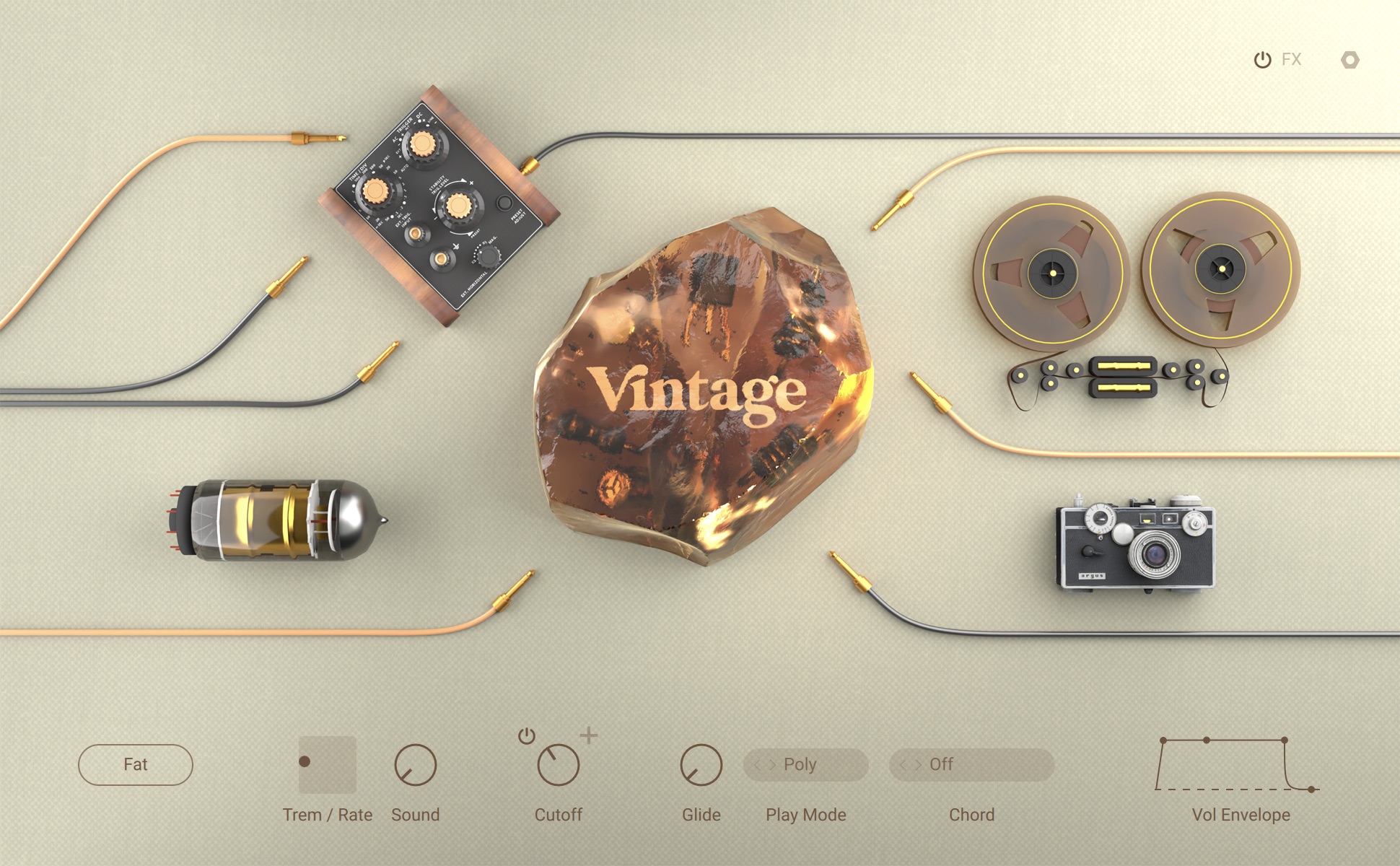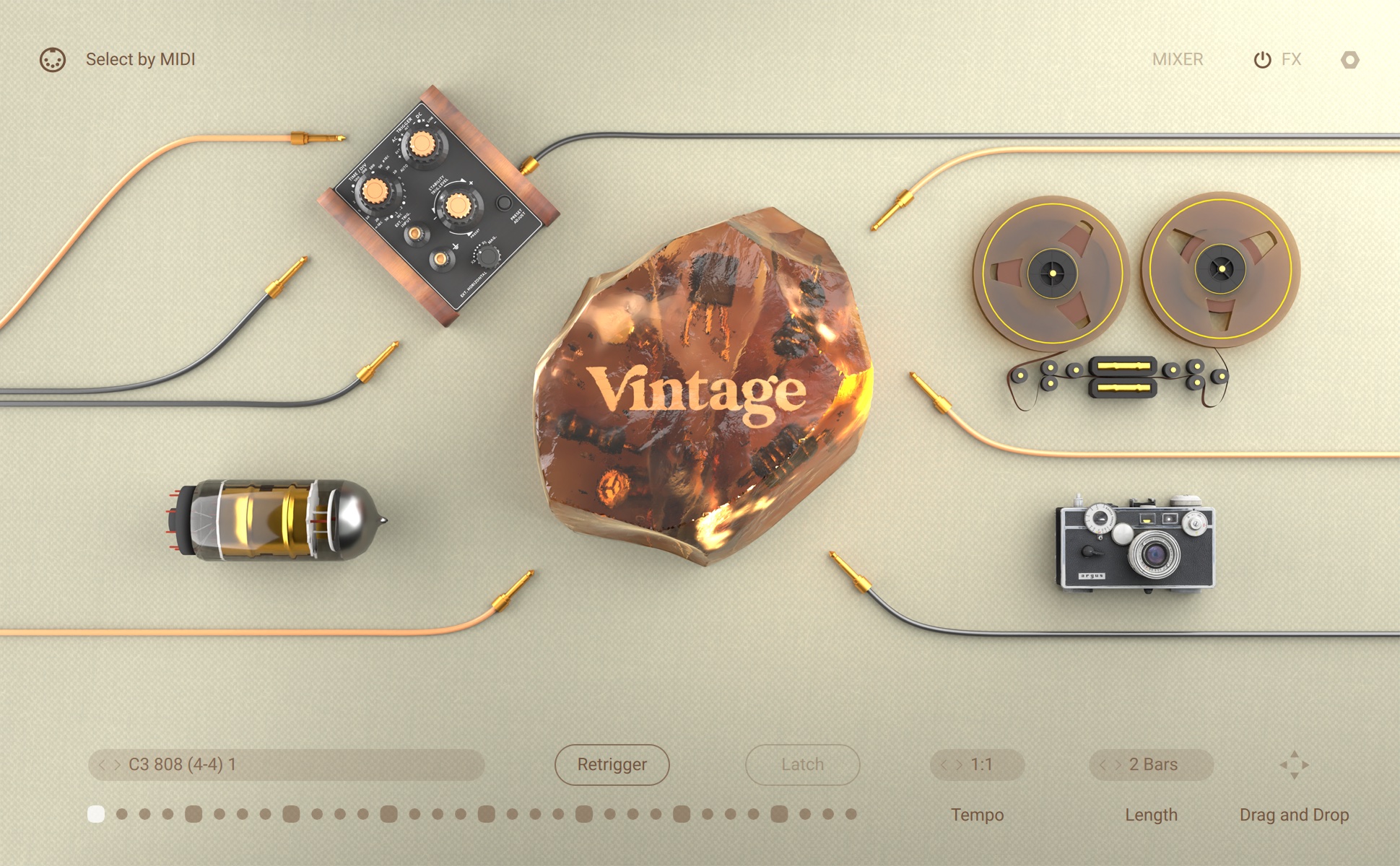Vintage Collection
A collection of 292 deep-sampled electronic instruments that deliver the rich, timeless warmth of analog synthesis, tube compression, and tape saturation
A collection of 292 deep-sampled electronic instruments that deliver the rich, timeless warmth of analog synthesis, tube compression, and tape saturation. Draw from the sounds of some of the most priceless, sought-after synths, drum machines, and classic gear, all ready to add the highest quality textures and timbres to any production in any genre.
Melodic Instruments in the Vintage Collection
Melodic Instruments feature different sets of parameters that enable you to explore sound variations and create a variety of articulations and musical gestures.
The Main page consists of the following parameters:

Fat: Activates the unisono effect that creates a thick and wide sound using additional voices.
XY Control: Adjusts two instrument or effect parameters that enable you to make drastic changes to the sound. One parameters is controlled using the X-axis, while the other parameter is controlled using the Y-axis. Each instrument in this collection features one of the following parameter assignments.
Trem / Rate: Adjusts the amount of tremolo on the X-axis, and the speed of tremolo on the Y-axis.
Drive / Dirt: Adjusts the amount of drive (distortion) on the X-axis, and the amount of dirt on the Y-axis.
Bit / S. Rate: Adjusts the amount of bit crushing on the X-axis, and the amount of sample rate reduction on the Y-axis.
Perc / Bass: Adjusts the level of the percussive sound layer on the X-axis, and the level of the bass sound layer on the Y-axis.
Pitch / Drive: Adjusts the amount of pitch fluctuation (wow and flutter) on the X-axis, and the amount of drive (saturation) on the Y-axis.
Sound: Morphs between different timbre settings. Turning the control fully to the left produces a neutral sound.
Cutoff: Adjusts the cutoff frequency of the filter. Additional filter settings can be accessed using the + button next to the Cutoff control.
+ (Filter Panel): Opens the Filter panel that provides additional filter settings, including the filter type, resonance, and modulation. For more information, refer to Filter Panel.
Glide: Adjusts the duration of the glissando effect, which makes one pitch glide to the next when playing a second MIDI note at the same time. Glide will only take effect if Play Mode is set to Mono or Legato.
Play Mode: Selects one of three modes that determine the Instrument's response to MIDI input. Poly allows multiple notes to be played polyphonically. Mono only allows one monophonic note to be played at the same time. Legato only acquires new pitch information when playing a second MIDI note at the same time without starting a new note event.
Chord: Selects a chord to be played when pressing a single key. When Off is selected, keys trigger individual notes. You can open the drop-down menu by clicking on the name and selecting an entry from the list. Alternatively, you can use the left and right arrow buttons to select the previous or next entry, respectively.
Vol Envelope: Adjusts the Instrument's volume envelope, which consists of attack, decay, sustain, and release stages. You can adjust each envelope stage by clicking and dragging the individual segments in the display.
Filter Panel
The Filter panel provides additional filter settings, including the filter type, resonance, and modulation.
The panel consists of the following menus and parameters:

Resonance: Adjusts the resonance amount of the filter. Turning the control to the right makes the frequency content at the cutoff frequency more pronounced.
Vel->Freq: Adjusts the amount of velocity sensitivity for the cutoff frequency. When set to 0, the cutoff frequency does not change depending on note velocity. When turning the control to the right, the cutoff frequency changes according to the note velocity to a variable degree.
Lfo Amount: Adjusts the amount of modulation applied from the the LFO (low-frequency oscillator) to the cutoff frequency.
Lfo Rate: Adjusts the speed of modulation applied from the the LFO (low-frequency oscillator) to the cutoff frequency.
Type: Selects the filter mode that will determine the basic sound character of the filter. The available filter modes differ between presets.
Drum and Percussion Instruments in the Vintage Collection
Drum Instruments have a dedicated set of parameters that enable you to explore rhythmic variations by selecting different patterns and altering the playback behaviour.
You can play tones in the range from C0 to B0, single drum hits in the range from C1 to B2, and trigger pattern playback in the range from C3 to B3.
Each Instrument contains a kit consisting of a number of different drum pieces. You can edit parameters on both the Main page and the Mixer page for each drum piece individually.
To select a drum piece for editing, activate Select by MIDI and play the respective note, or go to the Mixer page and use the Drum Piece selector.
The Main page consists of the following parameters:

Select by MIDI: Activates selection of a drum piece for editing according to the last played note.
MIXER: Shows the Mixer page with additional sound settings. For more information, refer to Mixer Page.
Pattern Browser: Selects the rhythmic preset used for the selected pattern. You can open the Pattern browser by clicking on the name and select an entry from the list on the right side of the menu. Both the collection and the various categories can be selected on the left side of the menu. The slider in the bottom left corner adjusts preview volume. Clicking on the speaker icon switches preview on or off. To change the pattern you are editing, click on the left and right arrow buttons next to the preset name. Alternatively, you can activate Select by MIDI to change patterns from your MIDI controller.
Pattern Display: Shows the position of the playback relative to the pattern.
Retrigger: Switches pattern retriggering on or off. When switched on, pressing a second key will start playback of the new pattern from the beginning. When switched off, the new pattern will continue playing relative to the current playback position.
Latch: Switches key latching for the patterns on or off. When switched on, the pattern keeps playing even when the key is released.
Tempo: Switches between three different tempo divisions relative to the host tempo. The pattern can be played back at the host tempo (1:1), at half the host tempo (1:2), and at double the host tempo (2x). You can open the drop-down menu by clicking on the name and select an entry from the list. Alternatively, you can use the left and right arrow buttons to select the previous or next entry, respectively.
Length: Switches between two different lengths for the pattern playback, 1 Bar or 2 Bars. You can open the drop-down menu by clicking on the name and select an entry from the list. Alternatively, you can use the left and right arrow buttons to select the previous or next entry, respectively.
Drag and Drop: Exports the pattern as a MIDI file for use in your DAW. You can export the pattern simply by dragging and dropping the arrow icon into a MIDI track in your DAW.